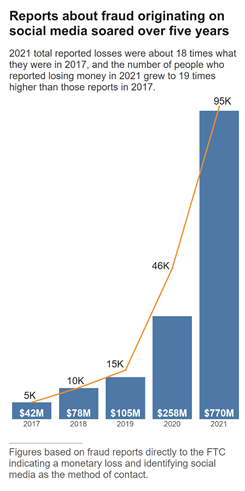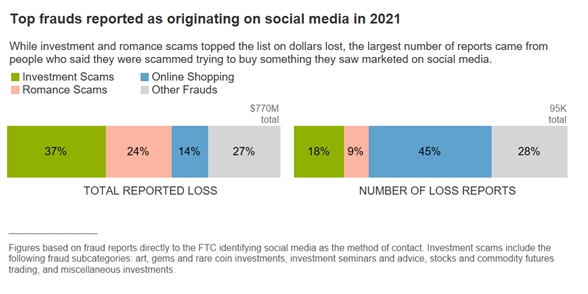
Social media permeates the lives of many people – we use it to stay in touch, make new friends, shop, and have fun. But reports to the FTC show that social media is also increasingly where scammers go to con us. More than one in four people who reported losing money to fraud in 2021 said it started on social media with an ad, a post, or a message.[1] In fact, the data suggest that social media was far more profitable to scammers in 2021 than any other method of reaching people.[2]
 More than 95,000 people reported about $770 million in losses to fraud initiated on social media platforms in 2021.[3] Those losses account for about 25% of all reported losses to fraud in 2021 and represent a stunning eighteenfold increase over 2017 reported losses. Reports are up for every age group, but people 18 to 39 were more than twice as likely as older adults to report losing money to these scams in 2021.[4]
More than 95,000 people reported about $770 million in losses to fraud initiated on social media platforms in 2021.[3] Those losses account for about 25% of all reported losses to fraud in 2021 and represent a stunning eighteenfold increase over 2017 reported losses. Reports are up for every age group, but people 18 to 39 were more than twice as likely as older adults to report losing money to these scams in 2021.[4]
For scammers, there’s a lot to like about social media. It’s a low-cost way to reach billions of people from anywhere in the world. It’s easy to manufacture a fake persona, or scammers can hack into an existing profile to get “friends” to con. There’s the ability to fine-tune their approach by studying the personal details people share on social media. In fact, scammers could easily use the tools available to advertisers on social media platforms to systematically target people with bogus ads based on personal details such as their age, interests, or past purchases.
Reports make clear that social media is a tool for scammers in investment scams, particularly those involving bogus cryptocurrency investments — an area that has seen a massive surge in reports.[5] More than half of people who reported losses to investment scams in 2021 said the scam started on social media.[6] Reports to the FTC show scammers use social media platforms to promote bogus investment opportunities, and even to connect with people directly as supposed friends to encourage them to invest. People send money, often cryptocurrency, on promises of huge returns, but end up empty handed.[7]
After investment scams, FTC data point to romance scams as the second most profitable fraud on social media. Losses to romance scams have climbed to record highs in recent years. More than a third of people who said they lost money to an online romance scam in 2021 said it began on Facebook or Instagram.[8] These scams often start with a seemingly innocent friend request from a stranger, followed by sweet talk, and then, inevitably, a request for money.[9]
While investment and romance scams top the list on dollars lost, the largest number of reports came from people who said they were scammed trying to buy something they saw marketed on social media. [10] In fact, 45% of reports of money lost to social media scams in 2021 were about online shopping. In nearly 70% of these reports, people said they placed an order, usually after seeing an ad, but never got the merchandise. Some reports even described ads that impersonated real online retailers that drove people to lookalike websites. When people identified a specific social media platform in their reports of undelivered goods, nearly 9 out of 10 named Facebook or Instagram.[11]

Together, investment scams, romance scams, and online shopping fraud accounted for over 70% of reported losses to social media scams in 2021. But there are many other frauds on social media too, and new ones popping up all the time. Here are some ways to help you and your family stay safe on social media:
- Limit who can see your posts and information on social media. All platforms collect information about you from your activities on social media, but visit your privacy settings to set some restrictions.
- Check if you can opt out of targeted advertising. Some platforms let you do that.
- If you get a message from a friend about an opportunity or an urgent need for money, call them. Their account may have been hacked – especially if they ask you to pay by cryptocurrency, gift card, or wire transfer. That’s how scammers ask you to pay.
- If someone appears on your social media and rushes you to start a friendship or romance, slow down. Read about romance scams. And never send money to someone you haven’t met in person.
- Before you buy, check out the company. Search online for its name plus “scam” or “complaint.”
To learn more about how to spot, avoid, and report scams—and how to recover money if you’ve paid a scammer—visit ftc.gov/scams. If you spot a scam, report it to the FTC at ReportFraud.ftc.gov.
[1] Excluding reports that did not specify a method of contact, 27% (94,541) of 349,177 2021 fraud reports to the FTC’s Consumer Sentinel Network indicating a dollar loss identified social media as the contact method. Reports provided by data contributors are excluded here and throughout this Spotlight because of differences in the collection of contact method information. This method of identifying reports indicating social media as the contact method differs from the method used in an October 2020 Data Spotlight titled “Scams Starting on Social Media Proliferate in Early 2020” because of enhancements to FTC’s collection of contact method information beginning in October 2020. Both methods show a significant increase in reports about fraud initiated on social media.
[2] Excluding reports that did not indicate a contact method, the total amount reported lost to frauds indicating social media as the contact method in 2021 was $770 million (26%), followed by website or app at $554 million (19%), and phone call at $546 million (18%). Note that the 2021 median individual reported losses were highest on phone fraud at $1,110 compared to $468 on frauds indicating social media as the contact method.
[3] Because the vast majority of frauds are not reported to the government, these numbers reflect just a small fraction of the public harm caused by frauds originating on social media. See Anderson, K. B., To Whom Do Victims of Mass-Market Consumer Fraud Complain? at 1 (May 2021), available at https://papers.ssrn.com/sol3/papers.cfm?abstract_id=3852323 (study showed only 4.8% of people who experienced mass-market consumer fraud complained to a Better Business Bureau or a government entity).
[4] In 2021, adults ages 18-39 submitted fraud loss reports indicating social media as the contact method at a rate 2.4 times higher than adults 40 and over. About 92% (87,048 reports) of 2021 fraud loss reports indicating social media as the contact method included age information. This age comparison is normalized based on the number of loss reports per million population by age during this period. Population numbers were obtained from the U.S. Census Bureau Annual Estimates of the Resident Population for Selected Age Groups by Sex for the United States (June 2020).
[5] See FTC Consumer Protection Data Spotlight, Cryptocurrency buzz drives record investment scam losses (May 17, 2021), available at https://www.ftc.gov/news-events/data-visualizations/data-spotlight/2021/05/cryptocurrency-buzz-drives-record-investment-scam-losses.
[6] Excluding reports that did not indicate a contact method, 54% of 2021 loss reports to fraud categorized as investment related identified social media as the contact method. The top platforms identified in these reports were Instagram (36%), Facebook (28%), WhatsApp (9%), and Telegram (7%). Reports that did not indicate a platform are excluded from these calculations. The median individual reported loss on investment related fraud originating on social media was $1,800 in 2021.
[7]Excluding reports that did not indicate a payment method, cryptocurrency was indicated as the method of payment in 64% of 2021 investment related fraud reports that indicated social media as the method of contact, followed by payment app or service (13%), and bank transfer or payment at (9%).
[8] This figure is based on 2021 loss reports directly to the FTC categorized as romance scams and where the consumer identified an online platform. Of these, the top platforms identified as the starting point for the scam were Facebook (23%) and Instagram (13%).
[9] Excluding reports that did not indicate a payment method, the most frequently reported payment method for 2021 romance scam reports indicating social media as the method of contact were as follows: gift card or reload card (30%), cryptocurrency (18%), and payment app or service (15%). The 2021 median individual reported loss on romance scam reports indicating social media as the method of contact was $2,000.
[10] Excluding reports that did not indicate a payment method, the most frequently reported payment methods for 2021 online shopping reports indicating social media as the method of contact were as follows: payment app or service (29%), debit card (28%), and credit card (24%). The 2021 median individual reported loss on online shopping reports indicating social media as the method of contact was $115.
[11] Facebook was identified as the social media platform in 59% of these reports, and Instagram was identified in 27%.
